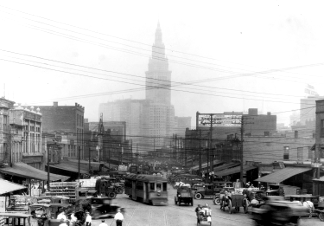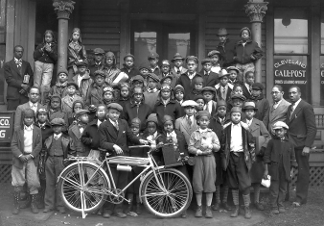JOHNSON, TOM L. (18 July 1854-10 Apr. 1911), mayor of Cleveland and a noted American Progressive, was born in Blue Spring, Ky., to Col. Albert W. and Helen Loftin Johnson. His family's CIVIL WAR Confederate support depleted their fortunes, so that Johnson earned money selling newspapers to finance his family. Johnson became an office boy in the Louisville Street Railway Co., two years later becoming company superintendent. Johnson's invention of the see-through glass farebox realized $20,000-$30,000, which he used towards purchasing, restoring, and profitably selling Indianapolis Street Railway. He expanded his traction holdings to St. Louis, Detroit, Brooklyn, N.Y., and in 1879 to Cleveland, after a battle against MARCUS A. HANNA†, who operated competing lines. In 1874, Johnson married Margaret (Maggie) Johnson; they moved to Cleveland around 1883. In 1889, Johnson established Cambria Co. steel company in Johnstown, Pa., and Lorain Steel Co. in Lorain, Ohio.
Johnson's political career was sparked by reading Henry George's books and becoming a fellow advocate of free trade and the single land tax, as well as George's personal friend. These ideas were in direct opposition to the principles that had made Johnson wealthy; this dichotomy dominated the rest of his life. In 1890, Johnson was elected as a Democratic for the U.S. House of Representatives from Cleveland's 21st district, and was reelected in 1892. In 1901, Johnson was elected Cleveland's mayor, campaigning on "home rule, 3-cent fare, and just taxation"; he was reelected for 3 terms. Using tent meetings and encouraging discussion, Johnson argued against monopolies and for MUNICIPAL OWNERSHIP of public utilities. He initiated the Group Plan and MALL, and with cabinet members NEWTON D. BAKER† and HARRIS R. COOLEY†, reformed and professionalized city hall. Reformer Lincoln Steffens stated "Johnson is the best mayor of the best governed city in America." Dissatisfaction with some of Johnson's reforms, particularly those dealing with street railways, led to his defeat against HERMAN C. BAEHR† in 1909. Johnson died less than 2 years later and was buried in Greenwood Cemetery, Brooklyn, N.Y., next to Henry George.
Johnson, Tom L. My Story (1913).
Murdock, Eugene C. "Life of Tom L. Johnson" (Ph.D. diss., Columbia University, 1951).
Last Modified: 17 Jul 1997 02:19:41 PMTom L. Johnson Papers, WRHS.
- Related Article(s)









